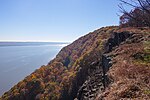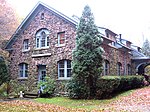Clover Stadium

Clover Stadium is a baseball park in Pomona, New York. It is the home field of the New York Boulders of the independent Frontier League. It has a seating capacity of 6,362 and it opened on June 16, 2011. The stadium is also home to the St. Thomas Aquinas College baseball team (NCAA Division II), who began playing all their home games at the venue in the spring of 2012. The Spartans are the 2014 and 2017 NCAA East Region Champions. The stadium is also home to the Manhattan Jaspers men’s baseball team since 2023. In 2012, the project to design and build the stadium received the Ward House Award from the Lower Hudson Valley Branch of the American Society of Civil Engineers. Originally named Provident Bank Park, naming rights were sold to Palisades Federal Credit Union in April 2016 and to Fiserv in January 2022 who renamed it Clover Stadium for the company's Clover point-of-sale-platform.
Excerpt from the Wikipedia article Clover Stadium (License: CC BY-SA 3.0, Authors, Images).Clover Stadium
Phil Tisi Way, Town of Ramapo
Geographical coordinates (GPS) Address External links Nearby Places Show on map
Geographical coordinates (GPS)
| Latitude | Longitude |
|---|---|
| N 41.17 ° | E -74.037 ° |
Address
Clover Stadium (Rockland Boulders Professional Baseball)
Phil Tisi Way 1
10970 Town of Ramapo
New York, United States
Open on Google Maps







